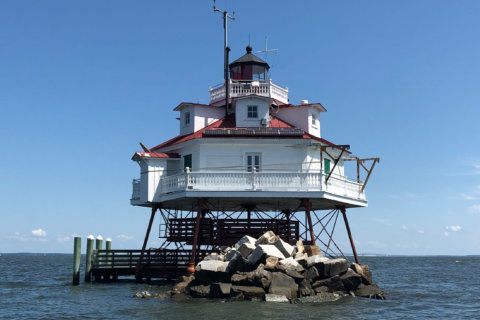This article was republished with permission from WTOP’s news partners at Maryland Matters. Sign up for Maryland Matters’ free email subscription today.
This content was republished with permission from WTOP’s news partners at Maryland Matters. Sign up for Maryland Matters’ free email subscription today.
Maryland could soon have nowhere to put its trash.
Two of the state’s incinerators may close in the next several years, following years of pressure from lawmakers and environmental activists. Their closure would amount to the end of incineration in the state — a goal for many environmental groups.
“We’re seeing a lot of successes,” said Mike Ewall, the founder and executive director of the Energy Justice Network, which advocates for the end of incineration. “There’s no way to do incineration in a good way.”
But the environmentalists’ success could also present state and local officials with a dilemma: Where should they put residential and commercial trash?
The closure of these incinerators, which consume 98% of the trash burned in the state, would have a dramatic effect. The Wheelabrator plant in Baltimore and the Resource Recovery Facility in Dickerson burned 1,320,765 tons of waste in 2017. In the same year, 2,277,011 tons of household waste were landfilled.
The Resource Recovery Facility accepts waste from across the state. Wheelabrator, the 10th-largest incinerator in the country, accepts waste from out of state as well.

A law passed in Baltimore City this spring forces the Wheelabrator incinerator to emit toxins at levels the company called “unachievable.”
Montgomery County Executive Marc B. Elrich (D) has said he wants to close the Resource Recovery Facility in Dickerson, but only when the county, which does not have an operating landfill, recycles a greater share of its waste.
Meanwhile, the state’s landfills are nearly full. They are expected to reach capacity in about 30 years, if they continue to be filled at the current rate. If the incinerators close, more waste would go into the landfills, which would accept raw waste, rather than the ash generated from the waste’s incineration.
Maryland Department of the Environment officials do not appear to be worried.
“Recycling programs in Maryland have always had to adapt to changes in the waste stream, recycling markets and availability of solid waste and recycling facilities,” said Jay Apperson, MDE’s deputy communications director. “And they will continue to do so.”
Environment Secretary Ben Grumbles noted Maryland recycles at a greater rate than the national average.
“Local governments, under Maryland Department of the Environment oversight, have improved their recycling programs,” he said in an emailed statement. “Many have significantly surpassed the minimum recycling rates under state law, even with strong headwinds from international and national forces.”
Maryland may recycle more than other states, but it also generates more waste per capita, according to the U.S. Environmental Protection Agency.
In 2017, MDE reported that the state recycled 44% of its waste. Montgomery County recycles about 60% of its waste; Baltimore City recycled less than 24% in 2017. The national average is around 35%.
Presumably, with nowhere to put their trash, the state and local jurisdictions would have to pay to ship it out of state. Bethesda Beat recently reported that Montgomery County, where there are no operating landfills, pays almost $1 million a year to ship ash and raw waste to Pennsylvania and Virginia.
Ewall said shipping and landfills are cheaper than incineration, even without considering the environmental and health impacts of incineration.
Wheelabrator and the Resource Recovery Facility are the worst single polluters in their jurisdictions. Baltimore City is among the top 1% most-polluted cities in the country, according to the EPA.
Yet ironically, because these plants generate energy, they are considered producers of renewable fuels, and benefit from the same tax credits as producers of wind and solar energy.
Republican Gov. Lawrence J. Hogan Jr.’s MDE has relaxed requirements that would have moved the state toward zero waste. In a 2017 executive order, Hogan rescinded an order signed in 2015 by former Gov. Martin J. O’Malley (D) that would have prohibited the expansion of landfills or established new ones and set an 85% waste diversion goal by 2040.
Baltimore’s tighter standards take effect on the first day of 2022.
Elrich also planned to close his county’s incinerator by 2022, when the county’s contract with the plant’s operator expires, but he walked back that goal this spring.
“I’m not shutting it down until we figure out how we’re gonna figure out how we’re gonna increase the amount of recycling,” Elrich told Bethesda Beat in March.
Ewall said despite the setback, Elrich has been “sincere on working toward zero waste.”
Maryland has 23 operating landfills, all but one of them run by — and accepting only waste from — the jurisdiction in which they are located. Many have contracts with incinerators, which extend the landfills’ lives by reducing the volume of waste. Ewall said ash is much more toxic than raw waste.
Baltimore City officials are working to expand the Quarantine Road Landfill, which would extend its life by about 30 years, according to the city Department of Public Works.
Montgomery County is looking to buy industrial property that would allow it to expand its recycling operation, officials announced late last month. The county said its recycling plant, which opened in Derwood in 1991, is receiving twice the amount of material it was designed to process.
“The key reason recycling is struggling is that we have 1990s systems, but expect 2050 results,” said Adam Ortiz, the director of Montgomery County’s Department of Environmental Protection. “It is our duty to take the leap into the next age of recycling.”







